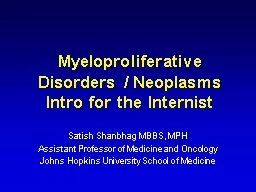

Myeloproliferative Disorders Neoplasms Intro for the Internist Satish Shanbhag MBBS MPH Assistant Professor of Medicine and Oncology Johns Hopkins University School of Medicine Objectives Internist focused review of the presentation diagnostic workup treatment and prognosis of the common myelo ID: 764453
Download Presentation The PPT/PDF document "Myeloproliferative Disorders / Neoplasms" is the property of its rightful owner. Permission is granted to download and print the materials on this web site for personal, non-commercial use only, and to display it on your personal computer provided you do not modify the materials and that you retain all copyright notices contained in the materials. By downloading content from our website, you accept the terms of this agreement.
Myeloproliferative Disorders / NeoplasmsIntro for the Internist Satish Shanbhag MBBS, MPH Assistant Professor of Medicine and Oncology Johns Hopkins University School of Medicine
Objectives Internist focused review of the presentation, diagnostic workup, treatment and prognosis of the common myeloproliferative neoplasms
Disclosures None
Stem Cell Basis of Hematopoiesis Normal Myeloproliferative disease Stem cells Progenitors Blood
The Chronic Myeloproliferative Disorders Acquired hematopoietic stem cell disorders characterized by overproduction of one or more of the formed (mature) elements of the blood Complicated by bone marrow expansion, extramedullary hematopoiesis (liver , spleen, l.n) , myelofibrosis and transformation to acute leukemia Transition between phenotypes common with latency period of decades
The Big 4 Chronic myeloid leukemia Polycythemia vera Essential thrombocythemia Primary myelofibrosis Chronic Eosinophilic leukemia Systemic Mastocytosis
Chronic Myeloid Leukemia Unregulated proliferation of myeloid cells in the bone marrow and accumulation of these cells in the blood Increased mature granulocytes (neutrophils, eosinophils and basophils) and their precursors in the blood Characteristic chromosomal translocation called the Philadelphia chromosomeBcr-abl translocation detectable in the blood by karyotyping, FISH or PCR.
Melo. Blood . 1996;88:2375. Pasternak et al. J Cancer Res Clin Oncol . 1998;124:643. Ph Chromosome → bcr-abl gene P 210 FUSION PROTEIN WITH CONSTITUTIVE TYROSINE KINASE ACTIVITY bcr-abl bcr Philadelphia Chromosome (or 22q-) Chromosome 9 q+ abl Chromosome 9 Chromosome 22
Typical presentation of chronic phase CML
Faderl et al. Ann Intern Med . 1999;131:207. Goldman. Curr Opin Hematol . 1997;4:277. CML: Clinical Presentation Chronic Phase ~ 85% Common symptoms: fatigue weight loss/anorexia Early satiety asymptomatic in ~ 50% Common signs: palpable splenomegaly basophilia Accelerated Phase and Blast crisis More aggressive disease with increased blasts and poorer prognosis
CML: Pre-Imatinib Survival Years from referral 4 3 2 1 0 8 7 6 5 0 0.1 0.2 0.3 0.4 0.5 0.6 0.7 0.8 0.9 1.0 Cumulative proportion surviving CML Phase Total Dead Chronic 2449 1043 Accelerated 479 276 Blastic 285 219 5 mo 28 mo 71 mo
Imatinib Mesylate – Targeted therapy in cancer BCR-Abl tyrosine kinase enzyme exists only in clonal cancer cells and not in normal patient cells Imatinib is a Tyrosine-kinase inhibitor which prevents the BCR-Abl enzyme product from initiating the signalling cascade necessary for cancer development, thereby causing cancer cell apoptosisMore ‘POTENT’ TKIs Nilotinib, Bosutinib, Dasatinib, Ponatinib have subsequently been developed.Bone marrow / stem cell transplant for select patients
Survival in newly diagnosed CP-CML by year of therapy. Kantarjian H et al. Blood 2012;119:1981-1987 ©2012 by American Society of Hematology
DASATINIB
JAK2 V617F in Myeloid Disease One mutation, many phenotypes Disease JAK2 V617F Prevalence PV 97% ET 60% PMF 60%
Janus kinase 2 (JAK2), is a gene on the short arm of chromosome 9 that encodes for a cytoplasmic tyrosine kinase A mutation in the JAK2 gene leads to constitutive tyrosine phosphorylation activity that promotes hypersensitivity to cytokines / growth factors and induces epo-independant erythrocytosis.
JAK2 G5073770T JAK2 V617F Scott, et al Lancet 2005 Signal transduction lesions in the MPN
JAK2 V617F : phenotypes of disease ET PV PMF Transition between phenotypes common with latency period of decades JAK2V617F
Bone Marrow Biopsy Normocellular bone marrow http://serpins.med.unc.edu/~fcc/Biology134_Folder/hem_cd/Large/05/0518.jpg
Bone Marrow Biopsy Hypercellularity and clustering of atypical megakaryocytes
Polycythemia Vera
Why is he erythrocytotic?
Polycythemia Vera Elevated totally body red cell mass; Hgb, Hct are surrogate markers Rule out dehydration, epo driven erythrocytosis Chronic disease with median survival of > 15-20 years with current therapy
Diagnostic Criteria for PV (PVSG) Major criteria Minor criteria Increased red cell mass 1. Platelet count >400,000/microL Males: ≥36 mL/kg 2. White blood cell count >12,000/microL* Females: ≥32 mL/kg 3. Serum vitamin B12 >900 pg/mL 2. Arterial oxygen saturation ≥92 %3. Splenomegaly Low serum epo levelsJAK 2 V617F mutationPancytosisBone Marrow panmyelosis
Objectives of therapy Symptom control – prevent pruritus, headaches Prevent thromboses Phlebotomy (goal Hct <45% men or <42% female ) Aspirin 81 mg po qd Cytoreductive agents such as hydroxyurea
Essential Thrombocythemia
ET secondary myelofibrosis
Essential Thrombocythemia Chronic non-reactive thrombocythemia that does not fit criteria for other MPNs Headache Syncope Atypical chest pain Livedo reticularisErythromelalgia (burning pain of the hands or feet associated with erythema and warmth)60% patients positive for JAK2 V617F
Treatment Young low risk patients may not need any therapy or just a baby aspirin daily Higher risk patients (those with prior h/o clots or elderly) benefit from cytoreduction with Anagrelide or Hydroxyurea n engl j med 353;1 july 7, 2005
Thrombocytosis and Acquired VW syndrome
Primary Myelofibrosis M egakaryocyte proliferation and atypia, usually accompanied by reticulin and/or collagen deposition in the marrow Demonstration of a clonal marker (eg, JAK2 or MPL) Leukoerythroblastosis on smeardoes not met criteria for other MPN SplenomegalyAnemia
Bone marrow in PMF Modern Pathology (2012) 25, 1193–1202
Blood smear in PMF http://imagebank.hematology.org/Content%5C969%5C1180%5C1180_full.JPG
PMF / secondary myelofibrosis PMF carries the worst prognosis among the MPNs, although survival is still measured in years PV and ET can show gradual progression to secondary myelofibrosis over decades
Therapies for PMF Bone marrow transplant is the only cure Ruxolitinib (JAK inhibitor) is a recently approved drug for treating symptomatic PMF that also reduces splenomegaly Hydroxyurea, Thalidomide and its derivatives have also been studied but not FDA approved
Hopkins500: Natural History Diagnosis 10 years 20 years N=405 N=283 N=57 slide courtesy Dr.Alison Moliterno
Thanks Dr. Doug Smith and Dr.Alison Moliterno for sharing slides and images